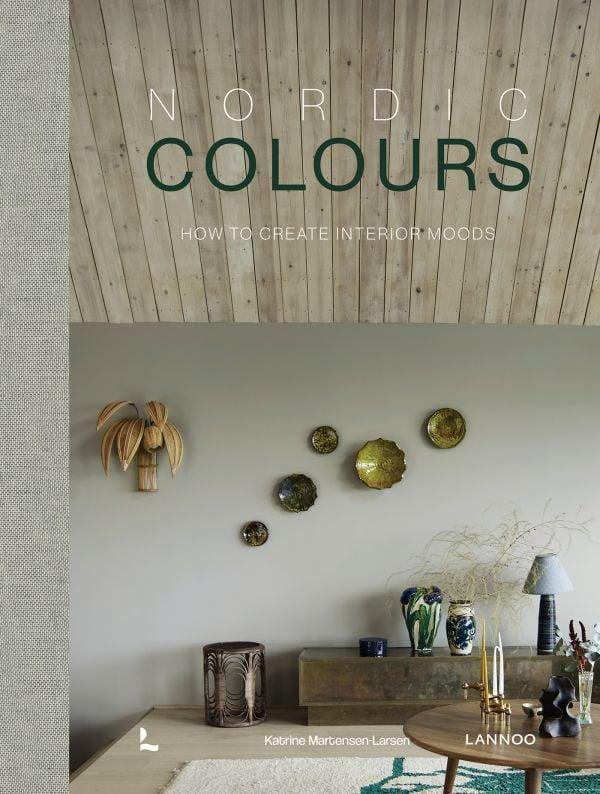

WORKING WITH MOOD BOARDS
Working with mood boards is an effective method, whether you want to enhance an existing design or start from scratch. You can create your mood boards on a fabric-covered board, which is convenient if you want the flexibility to rearrange them. In Nordic Moods, I provided a step-by-step guide on how to create mood boards yourself. If you haven’t got a bulletin board available, you can also lay your material samples directly on the floor or a rug, but remember to choose a surface that is representative of the space(s) you wish to design.
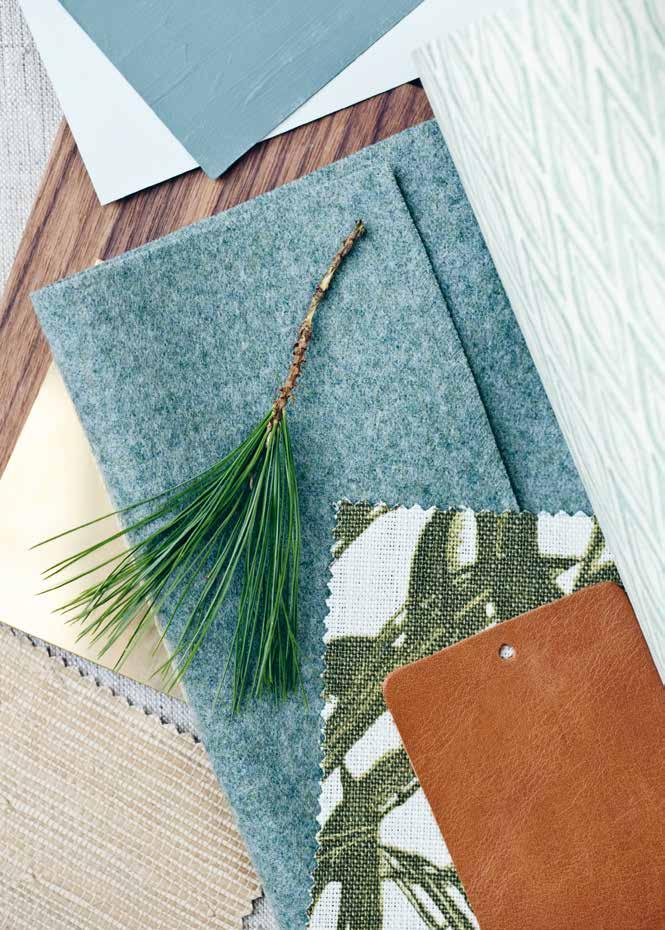
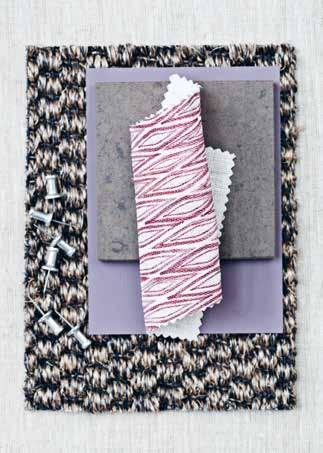
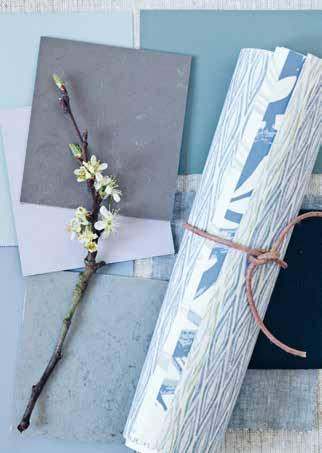
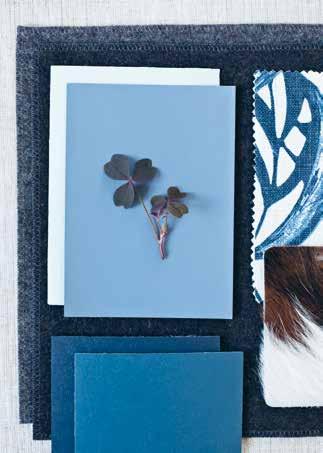
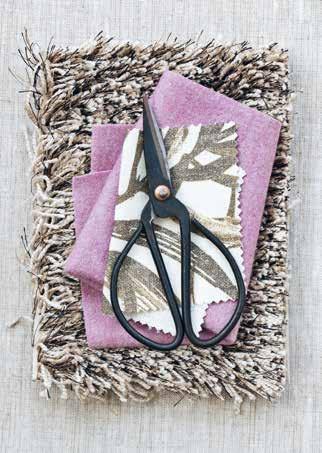
HOW TO FIND THE RIGHT COLOUR SCHEME
Finding the right colour palette is a personal journey. You need to find the colours that not only look good together but also evoke the feelings and moods you wish to achieve in your home. It’s essential that you thrive, gain energy, find peace, and achieve whatever you desire from your interior design. When it comes to colour choices, just like everything else in your home, the primary consideration should be your own preferences. Remember that.
If you find it difficult to choose colours, rest assured, you are not alone. The process can be both challenging and time-consuming, and it’s important to expect a fair amount of experimentation before everything clicks into place. A well-curated colour palette is crucial for creating a harmonious and, in my view, successful interior. If the colour scheme is discordant or cluttered, even the loveliest furniture and artworks in the most stylish spaces will not work effectively. I would wager that you wouldn’t feel comfortable either. Therefore, it is vital to invest the necessary time and effort in finding the right colours for your home.
When I talk about using a colour palette, I mean that merely selecting a single colour for each room or for your home is far from sufficient. Generally, you should use three to five colours per room. It’s the collective colours across all rooms that together form your unique palette.
If you prefer a neutral colour theme, you can blend several shades, such as off-white, beige, brown, grey, mocha, sand, mustard, and black, more freely than if you wish to work with bolder colours. In that case, I suggest you limit yourself to a maximum of three colours—perhaps a blueish, a greenish, and a greyish tone, or a reddish, a yellowish, and a brownish one. If you’re feeling adventurous, you might even allow one of the three colours to stand out more prominently or add a contrast colour.
The colours in your interior typically consist of wall colours, ceiling colours, trim colours, and the fabrics of your sofa or armchair. However, colours can also come from dining tables, chairs, and other small pieces of furniture, as well as from rugs, cushions, throws, curtains, and lamps. Additionally, there will be colours from wooden furniture, wood floors, and tiles, as well as from artwork, crafts, books, and plants, among other sources. In later chapters, I will delve deeper into many of these topics, but for now, let’s focus on which colours should be included. It may be a good idea to study Itten’s colour wheel and the seven contrasts, so acquire a colour fan (with large swatches) and start considering which colours you personally like and look at the contrasting colours. Maybe this can provide you with some inspiration.
The pure colours in Itten’s colour wheel are referred to as saturated, but they can also be mixed with white or black, in which case they are called broken or unsaturated. I would recommend choosing more muted tones than those you find in Itten’s colour wheel, but the principle of having a contrasting colour remains the same. If you get a colour fan from a paint manufacturer, they will automatically be much more subdued.
Now simply select some colours from your fan and see if they complement each other. Think about the atmosphere you want in your home and how colours can significantly affect your mood. For example, I personally cannot live with strong red colours, as they feel heavy and claustrophobic to me. In contrast, I feel uplifted and in a good mood with blue and greenish aqua colours.

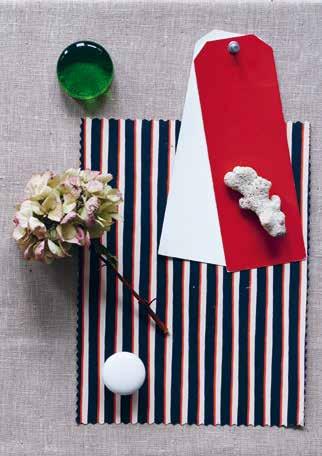
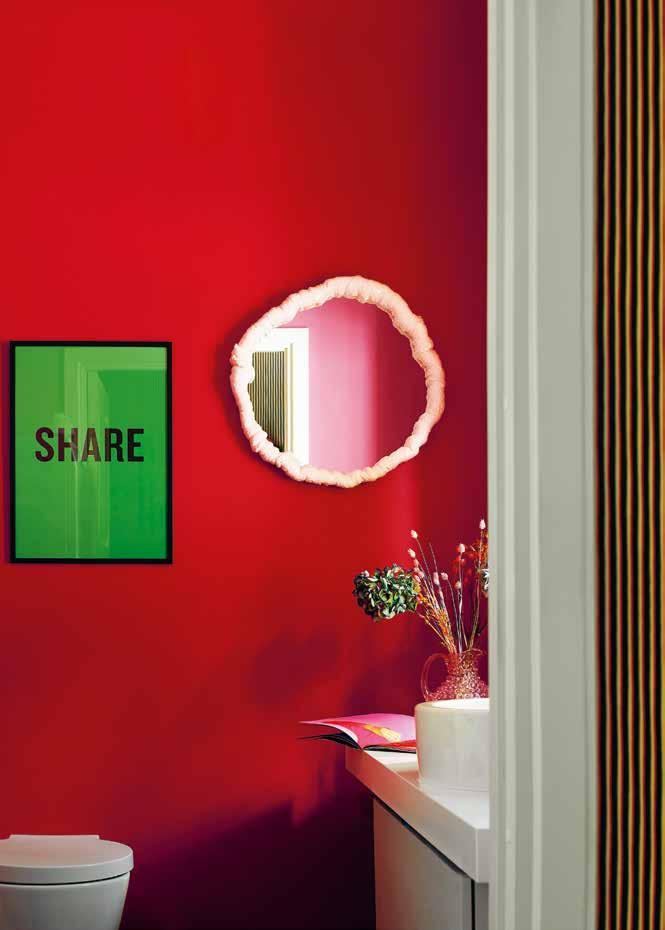
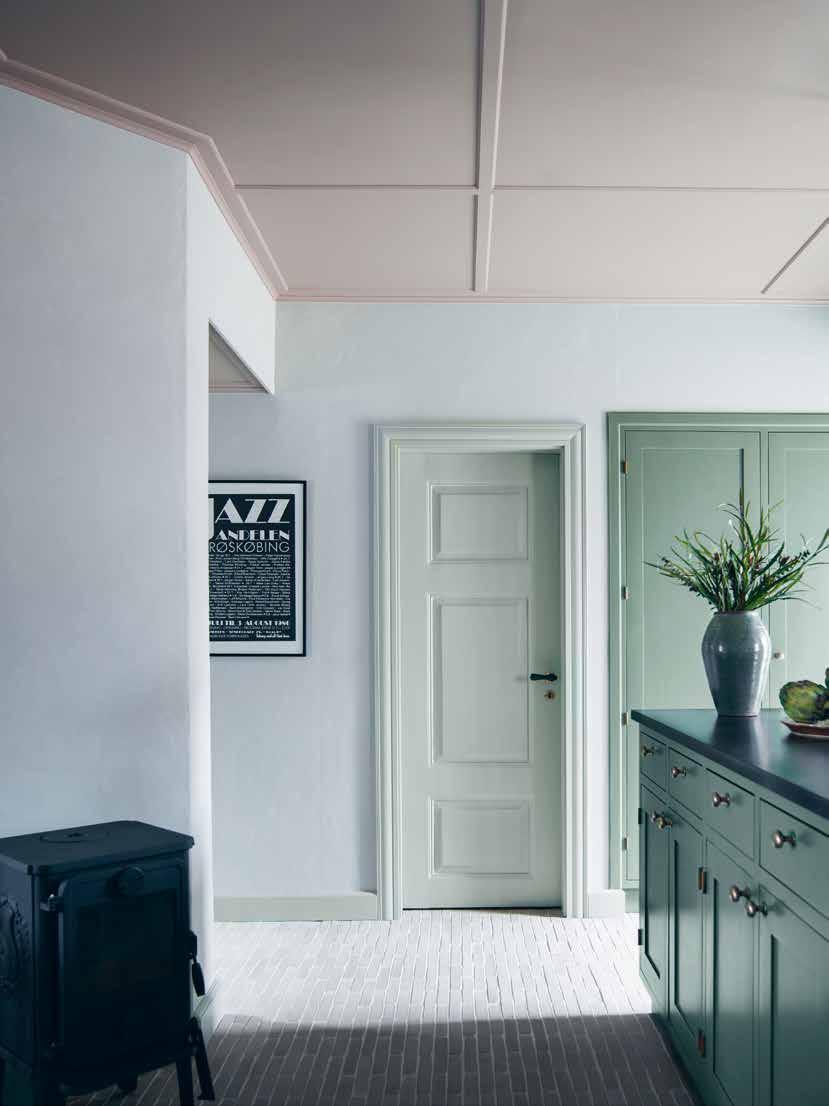
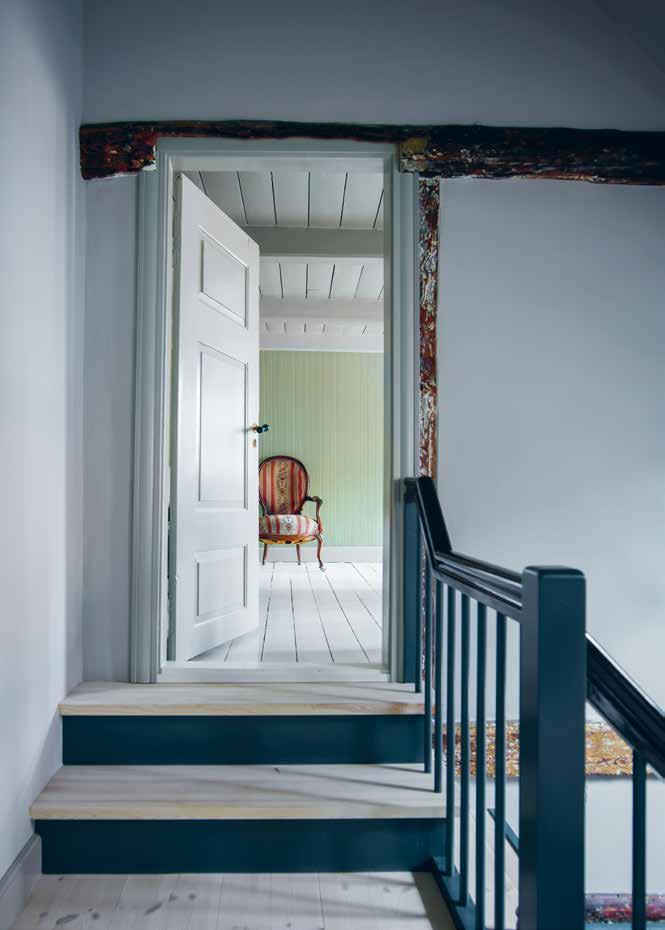
MOOD BOARD
The watery aquamarine hues are perfectly suited for a coastal home, and in my summer house by Nordstrand, I’ve embraced these very shades. The vibrant floral fabric on the cushions and pouf contrasts beautifully with the solid-coloured textiles, capturing all the colours found in nature right outside our windows. The bright and faded greens, delicate aqua, sandy tones, and blues represent the old fir trees, meadows, the sea, the beach, and the sky—elements I absolutely adore. It was my mother who insisted on incorporating some colour into the house, and she was absolutely right.
The colours in the Carnival fabric from Christopher Farr provide a foundation for the home’s overall colour palette. The sofa is upholstered in sand-coloured fabric, the cushions of the daybed are covered in a soft aqua linen, and the pillows are a mix of the patterned fabric and a solid light blue linen. I’ve also used the same fabric for curtains in front of the wardrobe. Various wool throws in sandy and aqua tones are scattered around, while an old woven rug with stripes in sea blue and beige adorns the floor. Above the dining table, blue sea-coloured pendants hang, and on the wall above the sofa is a piece created by my sister-in-law, Helene Blanche, painted by hand with ink on silk—a symbol for me of the view over the dunes towards the water during the blue hour.
The walls are painted nearly white, while the kitchen is a soft and very light blue. This is contrasted by black leather on the butterfly chair, a black table, black dining chairs, and the black cabinetry framing both the bay window and kitchen elements, including the large shelving unit for dinnerware above the kitchen counter. The tableware I’ve chosen consists of vibrant green and soft light green pieces—a newer set from Rosendahl and an older one from Aluminia that I collected and purchased at antique markets across the country.
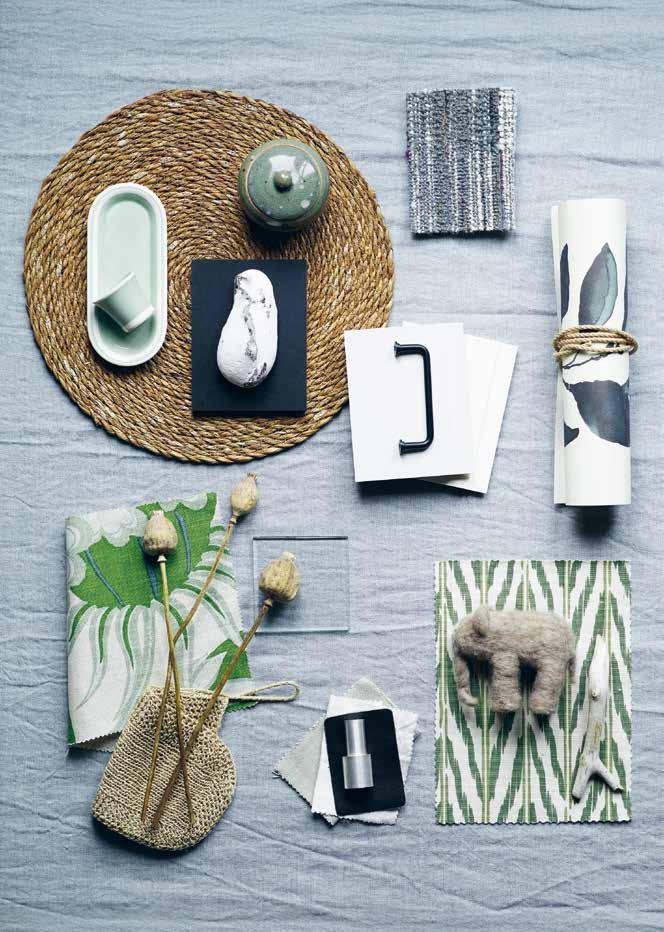
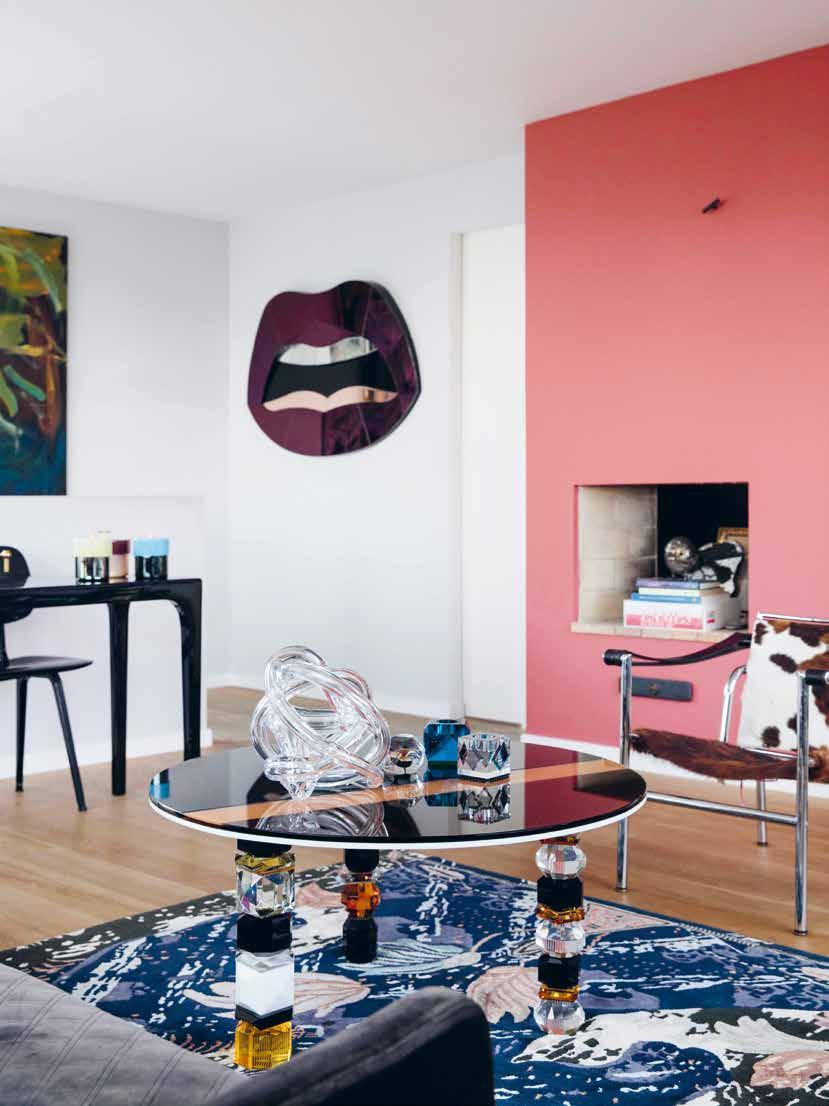

AN INTERFLOW OF COLOURS AND SHAPES
I have set out to explore the wonderful and unpretentious style universe of this couple, as it is as far removed from my own as you can get. So, where does it come from?
Rasmus, who graduated from the Danish Design School in Copenhagen, established himself as a freelancer right after finishing his education. Starting his own design firm had always been on the cards for him. His father, who was originally trained as a blacksmith, started a company that produced hospital furniture, so the household was always experimenting with fun little things and steel furniture. For Rasmus, finding a harmonious blend of design and functionality felt like playing when he was young. His mother, on the other hand, adored colours and whimsy and was always up for anything. The sense of colour must come from her, while the design enthusiasm stems from his father, Rasmus explains.
Andrea launched her company, Reflections Copenhagen, back in 2014, but in addition to being a designer, she has an extensive range of interior-related titles on her business card. Among other things, she has been an expert on various home improvement shows, authored a design book focused on wallpaper, and created several interiors for both businesses and private clients. Like Rasmus, Andrea was immersed in aesthetics and design from a young age. Her mother is a trained architect, so she grew up in an architect-designed house—albeit a wildly cosy and decorated one, she shares. “My mother was extremely skilled at combining colours and items, so I definitely inherited my slightly quirky and offbeat style from her.”
I ask the couple to describe their interior style and what inspires them decoratively. Andrea begins:
“I actually think we clutter a lot—and in reality, we are totally directionless. We embrace randomness and are guided by our whims. We’re not very deliberate, which is evident in many places. We don’t have a specific style, but we are probably fairly modern, steering clear of the light Nordic aesthetic. We like that style in general, but we just can’t figure out how to live in it. We need something that is crazier, more colourful, and wilder.”
Buildings, old porcelain, art, colours, patterns, and travels are some of the inspirations Andrea draws from. Sometimes she wanders around with loose ideas, like when she wanted to create an ‘Eye of the Tiger’ mirror. Suddenly, she began seeing eyes everywhere. For some reason, it is primarily colour that fills her thoughts. She loves colours, especially the combination of colours. Rasmus, on the other hand, keeps an eye on everything with shapes—a hole in a wall, a building, a glass, an old ceiling, a half-finished drawing, a broken vase. He is always on the go, looking inquisitively at everything he encounters along the way.
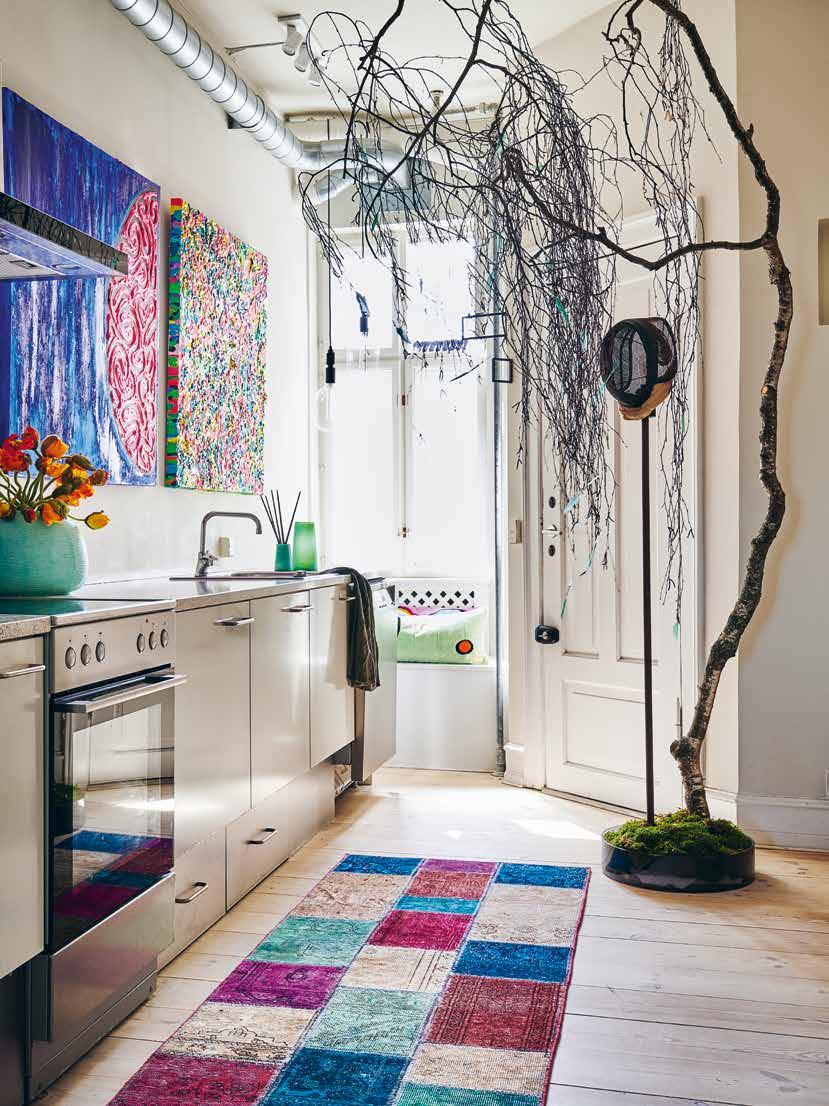

AN EXPLOSION OF IMPRESSIONS
With outstretched arms and the warmest smile, I am welcomed. Thomas is a true bon vivant. But it’s not just his heartfelt hospitality that leaves me in awe; my senses are already on high alert. As I ascend the stairs, muted classical music wafts towards me from the open door on the third floor. I love it when people throw their front doors wide open; it speaks volumes about their desire to engage with the world and meet new people.
It’s not only the music that flows freely from the open door; I’m also greeted by an inviting scent of freshness mixed with a gentle note of newly sprouted beech forest. At first, I only register the fragrance subconsciously, and perhaps that’s why it feels so delicate.
Before Thomas emerges from the back of the apartment, I notice that my sense of sight is now working overtime. The initial impressions have been so overwhelming that I struggle to maintain eye contact. Thomas is unfazed by my wandering gaze—he’s clearly used to it.
The extravagant trees and branches adorned with feathers, flowers, and leaves immediately capture my attention. Some hang from the ceiling, while others stand in large, beautiful vases and pots in corners and on dressers. In several places, they are even wrapped around lamps.
The walls are painted in subdued matte greys, warm greens, and beige earth tones, while a large old door from an Indian temple leans casually against the wall in the living room. Here also hangs the artwork Dead Artists Don’t Make Any Money by Klaus Köenig, while the other explosive artworks—all created by Thomas himself—testify to his immense imagination and creativity. One piece features flowers and branches spilling forth from a bare canvas, and above the sofa hang two round mirrors with decorative embellishments. Those are ‘yes-hat’ artworks, Thomas explains, adding that if you stand beneath one and take a selfie, you can say ‘yes’ to everything for the rest of the day.
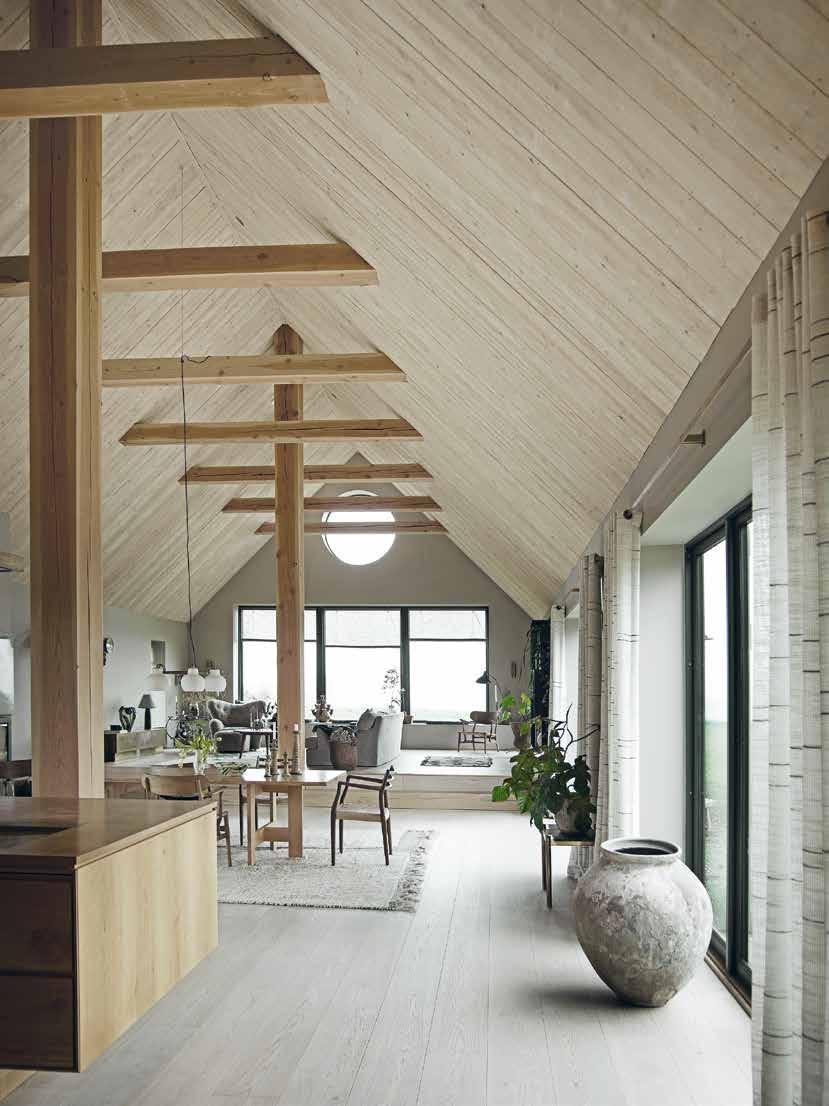
CHOICES THAT LAST A LIFETIME
To get closer to nature, Mette and Mikkel Adsbøl built their dream house not far from here about ten years ago. A whitewashed barn with a red tiled roof. They were tired of forest excursions feeling like a burdensome weekend project and wanted to live in the midst of nature. Their boys should grow up surrounded by open spaces and picturesque views of fields, and learn how to drive a tractor, just as they did when they were growing up.
“We both love old details and items with patina, and we never thought we would build and live in a new house, but we simply couldn’t find anything old that met our requirements,” Mikkel explains.
The new house resembles an old barn because, earlier in the process, the couple had considered a plot where there was indeed an old barn that could be renovated. Before the municipality decided that the residential area would be too large and the project fell through, the couple had already designed and renovated the barn down to the smallest detail—at least on paper.
“We were so excited about that barn and the layout we had devised, with the potential for an extremely high ceiling and a very unique room configuration, that we decided to build exactly that,” Mikkel clarifies.
Mette and Mikkel loved their newly built home but dreamed of having even more distance from their neighbours. When the opportunity arose to purchase the perfect plot of land, they jumped at the chance to start over. They wanted to build another barn, maintaining a similar internal structure, but this time with a bit more square footage and in wood, as they sought a more organic and streamlined expression.
To make the finances work, the couple hired a skilled carpenter, and Mikkel personally assisted throughout the construction phase. After two years of blood, sweat, and tears, in 2023 the family could celebrate their first Christmas in the new barn, a home where everything is now refined down to the smallest detail. Let me attempt to describe how I experienced it.
Upon entering through the front door, you step onto large marble slabs with an elegant cross pattern inlaid with brass strips. The symmetrically placed large wardrobes with curved fronts frame the hall while towering up to the apex. The ceiling is so surprisingly high that your eyes widen, making it impossible to maintain eye contact with Mikkel, who welcomes you.
MOOD BOARD
Despite the fact that the walls in this home are purely white, you are greeted by a vibrant explosion of colours—lime green, ochre, burnt brown, orange, Chinese red, and olive. You can almost smell and taste the essence of the medina in Marrakech and the bazaars of Istanbul.
Dark wooden figures and masks, shamans and dream catchers, along with dried flowers and leaves adorn the space. There are feathers, hides, antlers, and a mix of chains and pitchers, as well as silver cases and emblems combined with Chinese chests and candlesticks from French churches.
The floors are covered with thick Berber rugs, reminiscent of the ancient Rya rugs, featuring the characteristic zigzag patterns in black and white tones. However, what stands out the most are the many unique kilim rugs and cushions adorned with geometric patterns, stripes, and floral designs. The home is a true treasure trove of finds and collectibles, and you are in for a delightful surprise.
Nestled among the eclectic decor, a collection of books from around the world beckons visitors to lose themselves in tales of adventure and discovery. Each shelf is a portal to different cultures and perspectives, offering a source of inspiration and insight.
In the kitchen, hand-painted ceramics and artisan-crafted utensils display the owners’ dedication to both function and aesthetic appeal. The aromas of spices and herbs waft from the culinary corner, enhancing the senses with hints of far-off lands.
The eclectic mix of artefacts creates an atmosphere rich in cultural narratives, inviting guests to explore and appreciate the stories behind each piece. From the bold colours to the varied textures, every corner of the home reflects a passion for travel, art, and the beauty of craftsmanship, ensuring that this space is not just a residence, but a living gallery of experiences and memories.
In the garden, vibrant Rhododendron and fragrant jasmine create a serene outdoor oasis. The blend of natural elements and artistic expressions creates a harmonious balance, inviting nature indoors and inviting the outdoors into the home.
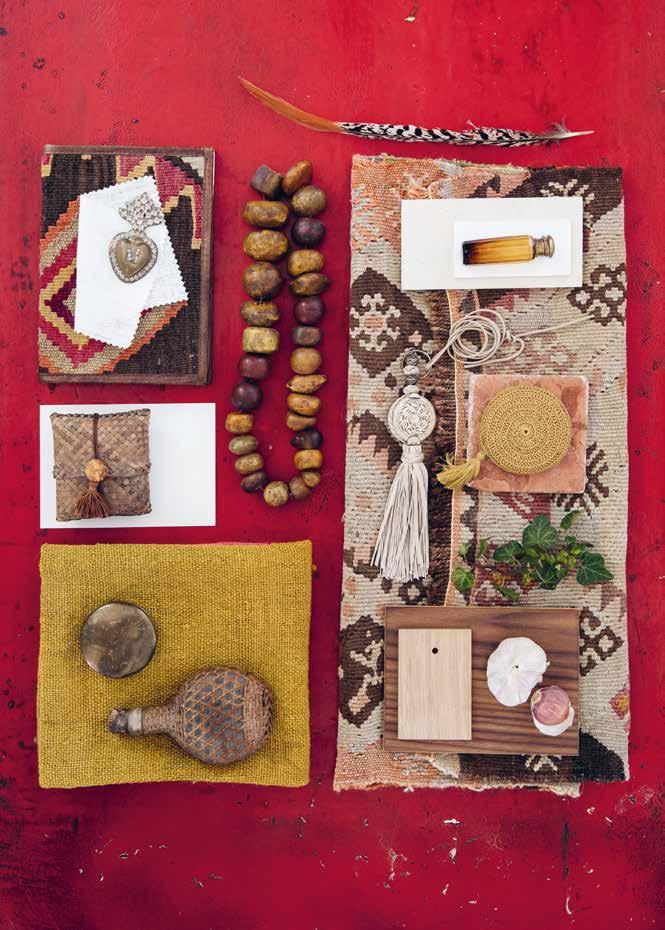
Acknowledgements
I would like to thank my editor, Carolijn Domensino, for encouraging me to write this book, and for her invaluable guidance throughout the process. You captured my imagination during a magical moment as I roamed through the architecture and colours of La Recoleta in Buenos Aires, Argentina—one of the world’s most famous cemeteries, where Evita Perón is buried. Shortly after our conversation, I began to compose this book in my mind.
A heartfelt thank you also goes to Mikkel Adsbøl, Kira Brandt, Frederik Johs, Mathilde Schmidt, and Rigetta Klint for your beautiful and vibrant photography, and, of course, to all the homeowners who allowed us a glimpse into their colourful universes.
Credits
Concept – text – styling: Katrine Martensen-Larsen Editing: Heather Sills Book design: Tina De Souter Bookdesign
Photography:
Frederik Johs: Futuristic Narnia, Scandic Oriental Kira Brandt: Coastal Calmness, Funky Reflections, African Vibes, Pastel Elegance, mood board images p.9, p.13-28 Mathilde Schmidt: p.4 Mikkel Adsbøl: Colour Extravaganza, Island Delight, Country Ambience, mood board images p.87, p.111, p.137, p.189, cover and back cover image Rigetta Klint /Håndværk bookazine: p.10, p.11
© Lannoo Publishers, 2025
D/2025/45/375 – NUR 454 ISBN: 978 90 209 7345 7 www.lannoo.com
If you have any questions or comments about the material in this book, please do not hesitate to contact our editorial team: art@lannoo.com.
All rights reserved. No part of this book may be reproduced or transmitted in any form or by any means, electronic, mechanical or otherwise, without the prior written permission of the copyright owners and publishers. All rights are reserved, including those for text and data mining, AI training and similar technologies.
Every effort has been made to trace copyright holders. If, however, you feel that you have inadvertently been overlooked, please contact the publishers.
